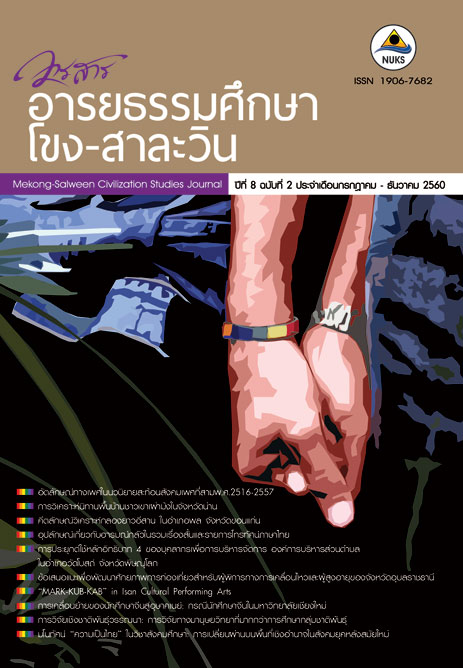การเคลื่อนย้ายของนักศึกษาจีนสู่อุษาคเนย์: กรณีนักศึกษาจีนในมหาวิทยาลัยเชียงใหม่ (Mobility of Chinese Students to Southeast Asia: A Case Study of Chinese Students in Chiang Mai University)
Main Article Content
Abstract
การเคลื่อนย้ายของนักศึกษาจีนสู่อุษาคเนย์: กรณีนักศึกษาจีนในมหาวิทยาลัยเชียงใหม่
บทคัดย่อ
การแผ่ขยายอิทธิพลจีนโดย “การเคลื่อนย้ายของคนจีน” ออกนอกประเทศไม่เพียงเกิดขึ้นในกลุ่มนักลงทุน ผู้ประกอบการ แรงงานและข้าราชการเท่านั้น แต่ยังพบว่า กลุ่มนักศึกษาจีนรุ่นใหม่ เป็นกลุ่มหนึ่งที่น่าสนใจต่อประเด็น “การเคลื่อนย้าย” ของคนจีน กลุ่มนักศึกษาจีนจำนวนมากเดินทางไปศึกษาต่อในประเทศตะวันตก ในขณะที่จำนวนไม่น้อยกำลังมุ่งสู่การศึกษาในประเทศอุษาคเนย์ รวมถึงประเทศไทยที่มีนักศึกษาจีนเข้ามาศึกษาต่อเป็นจำนวนมาก
บทความชิ้นนี้ นำเสนอ “การเคลื่อนย้าย” นักศึกษาจีนในอุษาคเนย์ โดยศึกษานักศึกษาชาวจีนที่เข้ามาศึกษาในมหาวิทยาลัยเชียงใหม่ มีวัตถุประสงค์เพื่อ 1) สำรวจแนวโน้มการเข้ามาของชาวจีนในภูมิภาคเอเชียตะวันออกเฉียงใต้ในรูปแบบนักศึกษา 2) วิเคราะห์เงื่อนไขปัจจัยการเข้ามาศึกษาต่อในระดับอุดมศึกษาของนักศึกษาชาวจีนในไทย ทั้งนี้ ผู้ศึกษาใช้วิธีการทบทวนวรรณกรรม การวิเคราะห์ผลทางสถิติ และการสัมภาษณ์นักศึกษาชาวจีนที่เข้ามาศึกษาต่อในระดับต่างๆ ของมหาวิทยาลัยเชียงใหม่ ซึ่งพบว่า มีนักศึกษาจีนเข้ามาศึกษาต่อในทุกระดับที่มหาวิทยาลัยเปิดสอนซึ่งเพิ่มขึ้นเป็นจำนวนมากในแต่ละปี เงื่อนไขสำคัญในการเข้ามาศึกษาต่อในมหาวิทยาลัยเชียงใหม่เป็นผลมาจาก 4 ประการหลัก ดังนี้ ประการแรก ปัญหาความตึงเครียดในการสอบเข้ามหาวิทยาลัยของจีน ประการที่สอง โอกาสทางการศึกษา ประการที่สาม ประสบการณ์ก่อนหน้าที่เคยมาประเทศไทย และประการที่สี่ ปัจจัยด้านอื่นๆ
Mobility of Chinese Students to Southeast Asia: A Case Study of Chinese Students in Chiang Mai University
Abstract
‘Mobility of Chinese people’ as resulted to the expansion of Chinese influence does not limit to those investors, entrepreneurs, labors, and state officials. There is also a movement of Chinese students mobilizing out of the homeland to further their studies in oversea countries. A large group of Chinese students travel to western countries for education; while some of them decide to earn the degree from universities in Southeast Asia. Thailand is considered as one of the preferable designated countries where Chinese students choose to come to study in each year.
The paper entitles, “the mobility” of Chinese students to Southeast Asia: a case study of Chinese students in Chiang Mai University” aims to 1) explore the mobility tendency of Chinese students to Southeast Asia countries, and 2) analyze factors affecting their decision to take higher education in the universities in Thailand. Based upon the literature review, statistical analysis, and interview with Chinese students of Chiang Mai University, the researcher finds out that in each year, there have been an increasing number of Chinese students being provided at Chiang Mai University. Results of the study also points out that the significant factors affecting their decision to study at Chiang Mai University are 1) tension of entrance examination in China, 2) education opportunity, 3) former experience in traveling to Thailand, and 4) other factors.
Downloads
Article Details
References
เกียรติชัย พงษ์พาณิชย์. (2559). อาเซียน-จีน ทั้งปีนเกลียว ทั้งเกี่ยวก้อย. กรุงเทพ: สำนักพิมพ์แสงดาว.
เชนคาร์ โอเด็ด. (2549). The Chinese Century จีน...มหาอำนาจโลก? . กรุงเทพ: บริษัท ฐานการพิมพ์ จำกัด.
ยศ สันตสมบัติ. (2557). มังกรหลากสี การขยายอิทธิพลเหนือดินแดนและพันธกิจเผยแผ่อารยธรรมในอุษาคเนย์. เชียงใหม่: วนิดาการพิมพ์.
ยุวดี คาดการณ์ไกล. (2555). เศรษฐกิจกับสิ่งแวดล้อมจีนสู่สมดุลใหม่แห่งการพัฒนา. เชียงใหม่: ล๊อคอินดีไซน์เวิร์ค.
ระบบสารสนเทศเพื่อการจัดการและการบริหาร มหาวิทยาลัยเชียงใหม่. (2559). Retrieved สิงหาคม 10, 2559, from https://mis.cmu.ac.th/cmumis/
วิทยากร เชียงกูล. (2553). การสังเคราะห์ผลการวิจัย ปฎิรูปการศึกษาของประเทศฟินแลนด์ นิวซีแลนด์ เกาหลีใต้ สหรัฐอเมริกา สหราชอาณาจักร จีน เวียดนาม และไทย. กรุงเทพ: โรงพิมพ์ภาพพิมพ์.
สถานีวิทยุซีอาร์ไอ (CHINA RADIO INTERNATIONAL). (2555). Retrieved สิงหาคม 10, 2559, from "เกาเข่า"ของประเทศจีน: http://thai.cri.cn/247/2012/07/12/225s200044.htm
สักกรินทร์ นิยมศิลป์. (2555). คลื่นลูกที่สี่: เอเชียตะวันออกเฉียงใต้กับการย้ายถิ่นของชาวจีนยุคใหม่. การประชุมสังคมวิทยาระดับชาติ ครั้งที่ 4 คณะกรรมการวิจัยแห่งชาติสาขาสังคมวิทยา สำนักงานคณะกรรมการวิจัยแห่งชาติ ร่วมกับจุฬาลงกรณ์มหาวิทยาลัย วันที่ 18-19 มิถุนายน 2555 . กทม.
สำนักงานคณะกรรมการอุดมศึกษา. (2558). Retrieved สิงหาคม 10, 2559, from สำนักงานคณะกรรมการอุดมศึกษา: http://www.info.mua.go.th/information/index.php
อรัญญา ศิริผล. (2557). ผู้ค้าจีนข้ามชาติในชายแดนลุ่มน้ำโขง. สังคมเปลี่ยนผ่าน/เปลี่ยนผ่านสังคม:รวมบทความวิชาการในวาระครบรอบ 50 ปี คณะสังคมศาสตร์ มหาวิทยาลัยเชียงใหม่, 395-407.
อักษรศรี พานิชสาส์น. (2554 ). เศรษฐกิจจีนในมุมมองนักเศรษฐศาสตร์ไทย. กรุงเทพ: โอเพ่นบุ๊กส์.
Allum, J. (2015). 2015 CGS International Graduate Admistions Survey Preliminary Applications. Washington: Council of Graduate Schools.
China Statistical Yearbook 2015. (2012). Retrieved August 10, 2016, from National Bureau of Statistics of China: http://www.stats.gov.cn/tjsj/ndsj/2015/indexeh.htm
Chinese Abroad Study Center . (2559). Retrieved สิงหาคม 10, 2559, from Chinese Abroad Study Center : http://123.lookood.com/
Department of Economic and Social Affairs, Population Division United Nations. (2015). International Organization for Migration. เรียกใช้เมื่อ 1 November 2559 จาก International Organization for Migration: http://www.iom.int/world-migration
Department of Economic and Social Affairs, Population Division. United Nations. (2015). http://www.worldometers.info/world-population/china-population/. เรียกใช้เมื่อ 31 October 2016 จาก worldometers: http://www.worldometers.info/world-population/china-population/
National Bureau of Statistics of China. (2012). Retrieved August 10, 2016, from China Statistical Yearbook 2015: http://www.stats.gov.cn/tjsj/ndsj/2015/indexeh.htm
Salmela, S. (2008). Chinese Student Mobility to Finland and the Students' Transnational Social Reality. Finland: Univesity of Tampere.
Singapore Government. (2015). Population in Brief 2015. Singapor: Singapore Government.
UNESCO Institute for Statistics. (2014). Retrieved August 10, 2016, from UNESCO Institute for Statistics: http://www.uis.unesco.org/Education/Pages/international-student-flow-viz.aspx
United Nations, D. o. (2015). http://www.worldometers.info/world-population/china-population/. Retrieved October 31, 2016, from worldometers: http://www.worldometers.info/world-population/china-population/
Yue, C. (2013). International Student Mobility: China. The International Mobility of Students in Asia and the Pacific, 18-28


